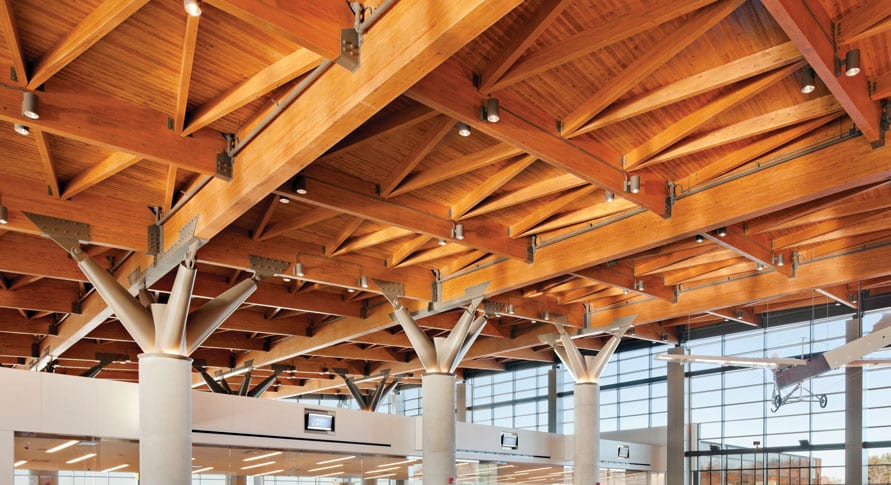Structural relocation of your heavy timber buildings requires significant time, resources, and planning –– not to mention professional expertise! A project like this can feel overwhelming, but if you know what to expect and plan accordingly, your move or lift for your Type IV structure can be simple, stress-free, and even enjoyable.
The experts here at DeVooght House Lifters compiled their top five tips to help you plan for and successfully execute your Type IV building’s move or lift.
What is Type IV Construction?
Heavy timber Type IV construction includes structures in which the exterior walls are made of noncombustible materials, and the interior elements are solid wood, or heavy timber. Many variations of Type IV construction exist, but heavy timber Type IV is always made with heavy timber (or mass timber.)
All wooden elements must meet prescribed dimensional requirements in heavy timber Type IV construction. Wood columns, beams, and girders must measure at least eight inches thick. Plans for flooring and roofs must be at least six inches thick.
Heavy timber Type IV buildings boast a solid structural mass: they can withstand much force while maintaining structural integrity. These structures typically hold up well against fire, and if the spread of fire is stopped quickly, the interior wood components can be repaired for continued use. However, if they catch fire and the internal beams, roof, or floor become engulfed, a large volume of water is required to quench the flames.
Heavy timber Type IV buildings are built to last, so many building owners opt to lift or relocate these structures. Below, we list our top five tips for moving or lifting your heavy timber Type IV building.
5 Tips for Relocating or Raising a Type IV Building
Consider Additional Insurance
If you work with a professional, experienced house-lifting firm, you shouldn’t anticipate significant damage during your lift or move. However, it’s wise to consider additional insurance to cover a building move.
An additional insurance policy protects you from the financial responsibility of damage resulting from preexisting issues with your home’s or building’s structural integrity. For example, if your Type IV home has weaknesses in a supporting beam, and it’s exacerbated during the move, additional insurance will cover the damages that might result.
Contact Your Mortgage Company
You’ll have many conversations leading up to your Type IV lift or relocation. In addition to securing a structural relocation and general contractor, you’ll need to secure the appropriate permits from your local governing body and contact your utility company to move powerlines (if necessary).
And if you’re still paying your mortgage, you will need to contact your mortgage company before you move your building. Your mortgage company must approve any changes that will alter the title or deed to your home if you’re still paying them. They technically own part of your building or home, and you’re legally obligated to get written permission before you choose to relocate it to a new property.
Confirm Plans for Your New Foundation
Whether you move or lift your building, you must plan for a new foundation. Your general contractor will complete this aspect of your project.
Whether you’re pouring or installing a new foundation or raising your current foundation, this is an aspect of your project that will require additional planning, both logistically and financially. Start these conversations with your contractors so you can anticipate costs and timelines.
Inspect for Rot
There’s always a chance for rot in heavy timber construction, especially in structures built before the widespread use of lumber treatment. Once wood rot starts, it isn’t very easy to stop. Your best bet for preserving the wooden elements of your Type IV build is finding threats for rot before it starts and then putting an end to it.
When you’re lifting or moving your home or building, hire an inspector to evaluate the health of the wooden components. The inspector will have access to elements of your home that might typically be hidden or inaccessible without major construction.
While you’re out of your home and have contractors available, inspect to ensure your building is still sound. If there are any signs of rot or weakness, you can discuss your options with your general contractor.
Work with a Structural Relocation Contractor You Trust
Lifting or relocating any permanent structure requires more than a simple DIY checklist. When planning a move or lift for a heavy timber Type IV building, we implore you to work with a structural relocation contractor.
As you know, some projects can be easily accomplished by yourself or with your own crew of friends. This is not so of a structural move or lift. In these cases, literal tons of building materials are lifted into the air. Individuals should never attempt these projects on their own. We recommend hiring a professional structural relocation contractor like DeVooght House Lifters.
Our team brings decades of experience, state-of-the-art equipment, and time-tested expertise to your projects. We have lifted and moved structures of nearly every kind, catering to each client’s unique needs and desires.
We know that moving or raising your building is a big decision. You can trust the team at DeVooght House Lifters to handle your project as if it were our own, and you can trust us to complete it safely and to the highest standards of excellence.
If you’re ready to embark on lifting or moving your heavy timber Type IV building, give us a call today!

